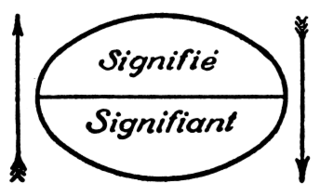Related Research Articles
Semiotics is the systematic study of sign processes and the communication of meaning. In semiotics, a sign is defined as anything that communicates intentional and unintentional meaning or feelings to the sign's interpreter.
A connotation is a commonly understood cultural or emotional association that any given word or phrase carries, in addition to its explicit or literal meaning, which is its denotation.

Roland Gérard Barthes was a French literary theorist, essayist, philosopher, critic, and semiotician. His work engaged in the analysis of a variety of sign systems, mainly derived from Western popular culture. His ideas explored a diverse range of fields and influenced the development of many schools of theory, including structuralism, anthropology, literary theory, and post-structuralism.

Visual rhetoric is the art of effective communication through visual elements such as images, typography, and texts. Visual rhetoric encompasses the skill of visual literacy and the ability to analyze images for their form and meaning. Drawing on techniques from semiotics and rhetorical analysis, visual rhetoric expands on visual literacy as it examines the structure of an image with the focus on its persuasive effects on an audience.
In semiotics, a sign is anything that communicates a meaning that is not the sign itself to the interpreter of the sign. The meaning can be intentional, as when a word is uttered with a specific meaning, or unintentional, as when a symptom is taken as a sign of a particular medical condition. Signs can communicate through any of the senses, visual, auditory, tactile, olfactory, or taste.
In semiotics, a modality is a particular way in which information is to be encoded for presentation to humans, i.e. to the type of sign and to the status of reality ascribed to or claimed by a sign, text, or genre. It is more closely associated with the semiotics of Charles Peirce (1839–1914) than Ferdinand de Saussure (1857–1913) because meaning is conceived as an effect of a set of signs. In the Peircean model, a reference is made to an object when the sign is interpreted recursively by another sign, a conception of meaning that does in fact imply a classification of sign types.
In the broadest sense, a code is a correspondence or rule between patterns. It can be an arrangement of physical matter, including the electromagnetic spectrum, that stores the potential to convey meaning. For instance, the pattern of vibration we call 'sound' when activated within the mind, triggers an image; say the word "cat". Also, seeing the shapes we call 'letters' forming the word makes one think of or visualize a cat. The words upon the screen were conceived in the human mind, and then translated into computer code.
In semiotics, the commutation test is used to analyze a signifying system. The test identifies signifiers as well as their signifieds, value and significance.
In semiotics, denotation is the surface or the literal meaning, the definition most likely to appear in a dictionary.
In semiotics, connotation arises when the denotative relationship between a signifier and its signified is inadequate to serve the needs of the community. A second level of meanings is termed connotative. These meanings are not objective representations of the thing, but new usages produced by the language group.
Decoding, in semiotics, is the process of interpreting a message sent by an addresser (sender) to an addressee (receiver). The complementary process – creating a message for transmission to an addressee – is called encoding.
Encoding, in semiotics, is the process of creating a message for transmission by an addresser to an addressee. The complementary process – interpreting a message received from an addresser – is called decoding.

S/Z, published in 1970, is Roland Barthes' structural analysis of "Sarrasine", the short story by Honoré de Balzac. Barthes methodically moves through the text of the story, denoting where and how different codes of meaning function. Barthes' study had a major impact on literary criticism and is historically located at the crossroads of structuralism and post-structuralism.
In semiotics, the study of sign processes (semiosis), the meaning of a sign is its place in a sign relation, in other words, the set of roles that the sign occupies within a given sign relation.
Urban semiotics is the study of meaning in urban form as generated by signs, symbols, and their social connotations.
Truth claim, in photography, is a term Tom Gunning uses to describe the prevalent belief traditional photographs accurately depict reality. He states that the truth claim relies on both the indexicality and visual accuracy of photographs.
The following is a list of semiotics terms; that is, those words used in semiotics, the discussion, classification, criticism, and analysis of the study of sign processes (semiosis), analogy, metaphor, signification and communication, signs and symbols. This list also includes terms which are not part of semiotic theory per se but which are commonly found alongside their semiotic brethren - these terms come from linguistics, literary theory and narratology.
The following outline is provided as an overview of and topical guide to semiotics:
Film semiotics is the study of sign process (semiosis), or any form of activity, conduct, or any process that involves signs, including the production of meaning, as these signs pertain to moving pictures. Film semiotics is used for the interpretation of many art forms, often including abstract art.

In semiotics, signified and signifier are the two main components of a sign, where signified is what the sign represents or refers to, known as the "plane of content", and signifier which is the "plane of expression" or the observable aspects of the sign itself. The idea was first proposed in the work of Swiss linguist Ferdinand de Saussure, one of the two founders of semiotics.
References
- 1 2 Borchers, Timothy (2006). Rhetorical Theory. Belmont, California: Thomson Wadsworth. p. 271. ISBN 0-534-63918-6.
- 1 2 Bate, David (2009). Photography: The Key Concepts. Burg. ISBN 978-1-84520-667-3.
- ↑ Scott, Clive (1999). The Spoken Image: Photography and Language. Reaktion Books. p. 355. ISBN 978-1-86189-032-0.
- 1 2 Seiter, Ellen. "Semiotics, Structuralism, and Television". Channels of Discourse, Reassembled: Television and Contemporary Criticism. University of North Carolina Press. Retrieved December 6, 2011.
- ↑ Crow, David (2010). Visible Signs: An Introduction to Semiotics in the Visual Arts. AVA Publishing. p. 55. ISBN 978-2-940411-42-9.
- ↑ Crow, David (2003). Visible Signs: An Introduction to Semiotics. AKA Books. p. 75. ISBN 978-2-88479-035-2.
- ↑ Seiler, Robert M. "Roland Barthes" . Retrieved June 25, 2018.